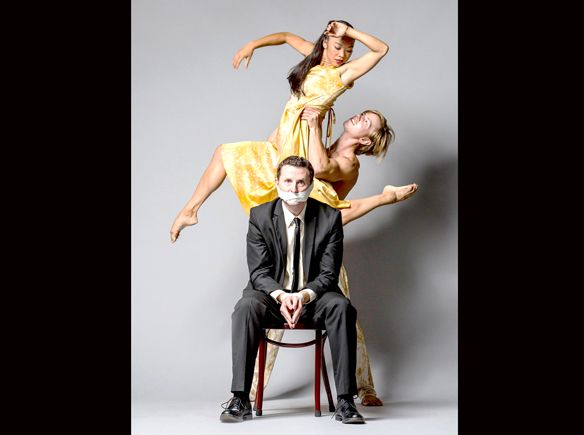If you have never gone to a ballet or contemporary dance performance and you love to laugh, check out “The Art of Falling” at the Ahmanson Theatre, Nov. 6-8. This production is a unique collaboration by two Chicago companies—Second City and Hubbard Street—that marries contemporary dance with comedy in a hilarious, yet touching exploration of life, love and relationships.
If you have never gone to a ballet or contemporary dance performance and you love to laugh, check out “The Art of Falling” at the Ahmanson Theatre, Nov. 6-8. This production is a unique collaboration by two Chicago companies—Second City and Hubbard Street—that marries contemporary dance with comedy in a hilarious, yet touching exploration of life, love and relationships.
This dance/comedy combination takes audiences on a relatable journey, with a story line that is contemporary and fun as well as emotional, as three distinct stories about relationships are interwoven. It even includes the ups and downs of a same-sex relationship. Described as lively, charming and sometimes absurd.
“The Art of Falling” was created by five choreographers, four writers and more than 30 dancers and actors under the award winning direction of Billy Bungeroth.
Second City has been performing sketch comedy since 1959 and this new collaboration, combining both dance and comedy, reaches new heights. The Chicago Tribune calls it “Hugely entertaining and strikingly emotional—not to be missed.”
Earlier in the year “Glorya Kaufman Presents Dance at the Music Center” gave us the stirring, totally amazing “Rodin” ballet. Now for a very brief run she offers L.A. audiences comedy with dance in the west coast premiere of “The Art of Falling.” See Second City and dance in an all new light at the Ahmanson Theatre, 135 N. Grand Ave., downtown L.A. Tickets are available at the Dorothy Chandler Pavilion Box Office, by calling 213-972-0711 or online at :musiccenter.org/hubbard.
**
‘Guards at the Taj,’ captures India in 1648
Even though the fictional story of “Guards at the Taj” is set in Agra, India in 1648, director Giovanna Sardelli feels the theme of Rajiv Joseph’s play delivers an important message for modern audiences because it raises timeless questions of what is beauty, what do we preserve, what do we sacrifice in the pursuit of whatever we believe is more important? And often, these sacrifices are human. I think this play really explores what’s lost in the choices we can make.”
Playwright Rajiv Joseph, perhaps best known for his Broadway hit “Bengal Tiger at the Baghdad Zoo,” was a 2010 Pulitzer Prize finalist for that play. In his latest work, “Guards at the Taj” he has created another dark comedy with deep undertones about the human condition. As the play begins Humayun (Raffi Barsoumian) and Babur (Ramiz Monsef) stand guard at the gates of the Taj Mahal. The two men are friends and are forbidden to talk while on duty.
Since that is not workable in a two person play, they do break the rules and their conversation is often playful as they recall all sorts of things. It is obvious that they are more than just friends, they are like brothers. Raffi’s character is more serious. He is always on time, believes in rules but on a lighter note, he can recognize the sounds of the birds who are singing in the night as they stand guard.
Ramiz, as Babur, is the whimsical one who is able to project himself into the future. He imagines what the world will be like hundreds of years from this night. We also learn that tomorrow, after 16 years of work, the most beautiful building ever created will finally be unveiled for the world to see—the Taj Mahal.
Babur is certain that the master builder will be rewarded for his creativity along with the workers, but will they? Humayun, thanks to his despotic father who is in charge of all the guards, knows that something dreadful will befall all the artists once the Taj is revealed to the world because the great ruler never wants another monument to be created that will be more exquisite than the Taj Mahal, built to honor his beloved wife.
Ned Mochel is the Violence Designer for what turns into a bloodbath at the hands of Humayun and Babur. To say more would reveal more than you need to know before seeing the play, but be advised that the results are bloody. As I said, this is not a normal comedy drama, it is very dark as it progresses to the surprising conclusion.
While I watched the play, I thought about the tragedy of the Holocaust. Humayun, like many Nazis, did what he had to do as a good guard for the ruler. On the other hand Babur is devastated by what he has done and is filled with remorse. As we contemplate what has just happened in the lives of these two simple men, we also see the similarities that will follow throughout the ages when people of conscience find themselves in very difficult situations Today, for example, art lovers and historians are horrified as ISIS terrorists seek to dominate the world, and in the process they are destroying irreplaceable ancient works of art that link us to our historical past.
Both actors, Raffi Barsoumian and Ramiz Monsef, turn in very fine performances, but in the end, despite what he has done, it is Babur (Monsef) that we can relate to if we were forced into an unbearable situation like the one both men faced.
Some portions of the play are shocking and terribly tragic, but there is also a sense of tenderness blended with moments of comic relief. Be advised, if you are very sensitive, some recreations of bloody violence may be difficult to handle. On the other hand, at the end of the play we find ourselves thinking about the past and the present as we ponder what we would do in a similar, horrible situation.
“Guards at the Taj,” at the Audrey Skirball Kenis Theatre at the Geffen Playhouse,10886 Le Conte Ave., Los Angeles, runs through Nov. 15. Tickets range from $60-$82, For information call (310) 208-5454 or online at www.geffenplayhouse.com Running time 1 hour, 30 minutes with no intermission.


















